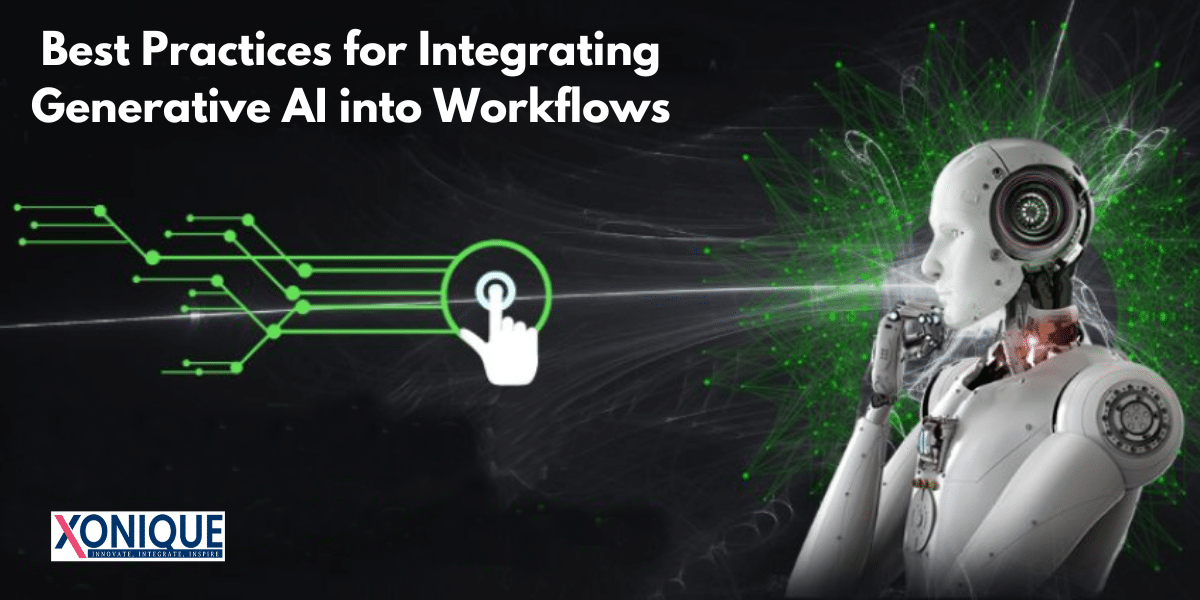Nowadays, everyone is talking about artificial intelligence, which is finding its way into increasingly different workflows and processes across diverse fields and industries. The word “generative AI” refers to an artificial intelligence technology that generates new content from users’ existing data and specifications.
Generative AI tools such as ChatGPT have caused a buzz of smug optimism among communication professionals. Have the days of writing lengthy copy, tallying footage, and performing media analysis ended? The idea of every PR person having a robot assistant is appealing. However, research indicates it’s best to exercise caution. Although Generative AI Integration Services has great potential, it has the potential for security, accuracy, plagiarism, and trust.
Generative AI could improve our intelligence quicker and more efficiently and focus on high-value tasks. Without thoughtful strategies and protections, the autonomous assistant could do more harm than good. What can they do to help communicate the potential benefits of AI without falling for potential risks?
In this article, we’ll discuss the most effective ways to securely and efficiently incorporate AI, which is generative AI.
What Is Generative AI?
Technology previously limited to scientists, IT developers, and mathematicians now has access to one search engine. Its results are awe-inspiring and ecstatic. ChatGPT has produced a “Google moment” that hints at the full range of possible uses and instances that can be made using generative AI.
Generative AI relies on machine learning models created and trained with large amounts of data to recreate an artificially intelligent version that most closely resembles its source without becoming identical in form and function. This means that these models are not determinate. The aim is to produce the most diverse variations of the training data set possible with the highest probability of aligning with this data set.
On the contrary, deterministic models produce similar results to specific frame parameters that use descriptions created by the hand of labels or tags. Tagging and labeling generate much manual work for extensive data. Therefore, deep learning methods such as neural networks (or deep neural networks (DNN) can be used to partition training data into multiple dimensions and label them.
Features Of Generative AI
It is an advanced machine-learning method with complex features designed for large datasets. It uses deep learning techniques to produce original text, video, and image content, generating fresh material such as texts, videos, or images.
The most important characteristics are:
Requires Training Data
Generative AI models are built on massive data sets. They require vast amounts of data to recognize patterns and determine how best to develop fresh material.
Recognizes Patterns
Within the realm of AI, patterns are recognized as the ability of the AI system to recognize connections in information “fed” to it. This is the basis that generative AI tools employ to build upon in order to produce fresh (original) information.
Relies On Neural Networks
The generative model is based on a neural network, a computer system that replicates how human brains process data. This mimics the brain because it uses the generative tool to analyze data and find patterns.
Many Applications
Generative AI has a vast array of application opportunities. This is a promising technology for sales, marketing, and product development. It’s equally for customer support technology, programming, and IT applications. It has potential for almost every business area and in every category.
It Can Be A Problem
A self-learning AI tool can only generate data as accurately as the one it is based on. It could produce incorrect or fictional data. The model has created a false impression based on information, sources, facts, and stories – an issue called “hallucinations.” It’s also susceptible to biases and dependent on the data it’s been trained with. There is also the risk of copyright infringement within AI-created content, specifically in cases where the model has been educated on copied material.
The Possibilities Of AI Generative
There’s much discussion on how generative AI could replace human-powered work. Therefore, many workers see AI as a threat and ignore the benefits of artificial intelligence. It automates repetitive tasks by incorporating AI into everyday procedures, allowing for more innovative, collaborative, and collaborative tasks. It not only results in a rapid increase in efficiency and effectiveness but also boosts the rate of innovation. In addition, it can lead to reductions in costs and improvements in quality as AI helps reduce workload in one way while, on the other, it prevents mistakes or enhances the detection of errors.
Generative AI and large language models are essential since they don’t provide rigid outputs to inputs like previous machine learning models. They offer a range of outcomes and options. If you train the generative AI and LLM using a massive amount of data in various environments and dimensions, they can develop complex relationships and dependencies. They can, for instance, interpret languages correctly and provide solutions to multiple questions about the topics covered within the learning set. OpenAI has demonstrated its impressive capabilities using ChatGPT and Google by using Bard.
Benefits Of Using AI For Workflow Management In Businesses
Artificial intelligence can transform many aspects of business operations, from customer service and supply chain management to employee training and recruitment. By processing vast information quickly and precisely, AI can provide insights that can assist businesses in optimizing procedures, spotting opportunities, and making data-driven decisions, which can boost efficiency and reduce expenses. AI technology can also perform repetitive tasks for workers and free them up for more engaging activities that require human interactions.
These are just a few of the benefits of using AI for business workflows:
- Improved scaling without the need to add more staff, which reduces the need for resources;
- Improved accuracy when analyzing information, resulting in greater accuracy in results and insight;
- A better risk management system allows businesses to reduce them before causing adverse harm.
- Innovation that is more effective results in more creative products and services
- Improved security – AI-powered security systems can detect and react to threats quicker and more accurately than traditional security measures.
- Customized marketing, which leads to better conversion rates.
Steps To Integrate Generative AI Into Your Workflow
First, let us dispel myths. Generative AI doesn’t intend to take over your job as a seasoned coach or project manager. It’s your reliable tool for testing, improving your ability to make decisions, and accelerating development.
Understanding The Power
Generative AI isn’t an all-inclusive solution. It is an excellent choice for specific tasks, including generating diverse and innovative solutions to complex issues, tearing innovation and problem-solving within your group, and producing reports, summary documents, and communications materials that meet the particular needs of the stakeholders involved, which saves time and making sure that the information is clear. Find hidden information through your project’s data by analyzing risk, finding trends, and improving opportunities.
Integration Strategies
Start with a pilot program that focuses on a particular task or problem. This will allow for controlled experimentation and learning. Examine the efficiency of AI technology in the context of your project. Many project management software packages include intelligent AI capabilities. Check these out before constructing customized solutions.
Make sure that the Generative AI Integration is simple and user-friendly for your project team. Analyze the effects of in-built AI on the project’s outcomes and adapt your plan when needed. Find potential issues and improve the approach.
Building the Foundation
Data is the Key. Generative AI thrives on data. Make sure you have top-quality, well-structured data that is readily accessible for use in training your AI model.
Timelines of past projects, budgets, resource allocations, and risk logs offer valuable information for AI learning. Best practices in the industry and benchmarks access to industry-specific information sets allow AI to gain knowledge from more extensive experiences and provide best-in-class strategies. Data from real-time projects: Alternatively, add the AI software with the project management software you use for real-time monitoring of the progress of your project, its resource usage, and potential problems.
Addressing The Concerns
Ethics and possible drawbacks need careful consideration. Keep in mind that generative AI is a tool; it is not a substitute for human experience. Utilize its power to help improve the quality of your decisions while maintaining human control and oversight.
Direct the AI toward desired results by setting clear goals, limitations, and ethical issues. Validate and interpret AI outputs: Don’t just take on AI ideas. Be sure to critically analyze them, considering the context of your project and your expertise. While using the AI software, provide feedback about its results to increase its accuracy and performance over time.
Essential Tips To Remember Before Integrating AI Tools Into Your Workflow
A presentation on machine learning technology using a touch screen for scientists, AI (AI) as well as neural networks as well as automation, and terms related to data mining and computer icons If you’re like most entrepreneurs, you’re constantly trying to improve your processes and effectiveness. If you need to make some kind of artificial intelligence (AI) to manage your business, then you’re losing the boat. AI can assist with anything from customer support and marketing to sales.
How do you determine what AI software is right for your company? Once you’ve identified the appropriate tool, how can you incorporate the tools into your workflow? Here are some tips to get you started.
Streamline Machine Learning Processes
AI is a technology that has the potential to transform the way companies operate and offer new possibilities to increase efficiency and effectiveness. What many do not realize is that AI can also simplify the process of machine learning.
Utilizing AI to discover patterns and relationships in the data set, organizations can develop machine learning algorithms much more efficiently and quickly, which frees up time and funds that can be used elsewhere. Using the top website to learn about AI machine learning will improve the efficiency of your workflow.
Automate Customer Service
AI Chatbots can be a fantastic option for improving customer service. By utilizing natural language processing (NLP), chatbots can comprehend customer questions and offer exact responses. Your customer service staff can tackle complicated issues while offering top-quality services to your clients. Automation With Generative AI Integration is accessible all day and all week, and your customers will get the help they require, even during non-business hours.
Improve Sales Processes
Predictive analytics is one type of AI that analyzes data from the past to anticipate the future. The information you gather can help improve your sales operations by determining the leads most likely to convert and establishing specific sales strategies suited to diverse customer segments.
Predictive analytics can also help you anticipate inventory needs to avoid excesses or shortages, and reviewing past purchases can help you with cross-selling and upselling activities.
Optimize Your Pricing Strategy
AI dynamic pricing adjusts pricing in real-time according to market conditions. By using dynamic pricing, you’ll ensure that you charge the correct cost for your goods or services, which can improve sales and increase profits.
Dynamic pricing also helps ensure that you remain on top of the market by quickly responding to any changes in competitors’ pricing. In addition, dynamic pricing may aid in managing your inventory by pricing products more expensive as they become less common and then lowering costs when the inventory is very high.
Simplify Business Processes
AI can solve problems in various ways; however, one of the most well-known and influential uses is robotic process automation (RPA). RPA bots are computers designed to perform repetitive tasks. For example, an RPA bot could create spreadsheets using data from a site or send regular email messages. Automating these functions allows companies to allow workers to concentrate on other crucial tasks. Furthermore, RPA bots can help improve consistency and accuracy by removing human errors.
Enhance Cybersecurity
Security information and event management tools are artificial intelligence tools businesses use to detect and mitigate cybersecurity risks. By gathering and analyzing data from various sources, SIEM tools are designed to detect any signs that an attempt at an attack or malware infection might have taken place.
These tools also enable you to monitor users’ activities so you can swiftly respond when admin privileges are mishandled, or data leaves the network without authorization. Additionally, SIEM software can help automate the process of creating security reports, making it much easier to follow regulations.
Protect Your Brand
Reputation management software employs AI to search the Internet for keywords or brand mentions relevant to your company. This allows you to react quickly to negative remarks or feedback.
Reputation management software may help you manage your reputation online by detecting potential problems and addressing them before they become significant issues. The software will also monitor social media to determine customer feedback.
Improve Your Recruiting Process
A system for tracking applicants (ATS) can be described as AI that assists businesses in managing jobs, application forms, and candidates. An ATS will help you publish your job on several job boards at the click of a button. Additionally, it will help you keep track of the steps each candidate takes when it comes to hiring. An ATS also helps you monitor your talent pipeline and detect trends in your hiring process. In addition, it will automate interview scheduling and onboarding.
The Challenges Of AI Integration Into Business Workflows
Despite the many benefits of integrating AI into business workflows, it also has some issues. One is data quality since AI models need vast amounts of high-quality data to produce exact outcomes. Because AI models heavily depend on enormous, varied datasets that are high-quality and reliable to learn from, good data quality could positively affect the efficiency and accuracy of the Generative AI Integration Process.
Data security and privacy are other significant issues because AI technology could expose sensitive data. Similar to transparency and bias, the most crucial factor is to ensure that your AI tools aren’t prejudiced against particular people or infringe on privacy laws.
The cost-intensive process of AI design and development is also a problem for small and medium-sized enterprises, particularly if the company needs AI specialists with the expertise to efficiently design and develop AI strategies. That brings us to a second problem: the requirement of skilled workers to create and oversee AI systems. Decision makers’ insufficient understanding of AI and its weaknesses can limit AI use.
The other issue to consider is ROI and cost. Implementing AI technologies can be costly. Companies may be unable to justify their investment when the return on investment isn’t immediately evident. But this is exactly where AI API may come in useful.
Integrating AI into existing business processes is difficult and takes considerable resources and experience. One of the issues you could face is integration with older technology, especially if earlier systems were not built to be designed with AI in mind. The challenges could be daunting, but the end result will likely be greater than the challenges by a mile. Do you remember all the benefits that we talked about earlier? First, you have to understand the reason for integrating AI initially.
Overcoming The Challenges Of AI adoption
Overcoming the hurdles to AI implementation requires tackling the difficulties that arise from integrating AI within existing business processes. One significant challenge is the need for more knowledge and skills to create and implement AI solutions. To address this issue, spend money on training and acquiring experts with experience in AI creation and deployment.
Another issue is the requirement to collect large quantities of top-quality information to efficiently train AI models. To overcome this, it is necessary to improve data collection methods, invest in quality data, and manage instruments. Concerns regarding ethics in AI deployment, like bias and privacy, must also be considered. To do this, it is crucial to develop standards of ethics regarding AI design and deployment and ensure that AI applications are designed and implemented in a moral and accountable manner.
Conclusion
As more people have access to customized generative AI or LLM models, such as ChatGPT by OpenAI and Bard from Google, the barriers to adapting generative AI into your business process have dropped significantly. At the same time, the number of possibilities for use has increased dramatically. Specialized AI developers and researchers do not have to design custom-made machine-learning models. However, training models that are generative AI and LLM models are still required for experts with expertise.
Generative AI models can be utilized as a part of the beginning, significantly cutting down AI projects in terms of complexity, work, and expense. It is also evident that the requirements for know-how for users are considerably less (to a degree) because questions can be customized according to their language style, as per their comprehension, as no set syntax of query is needed that reduces the creation and learning effort required to handle a variety of queries. Ultimately, the size and complexity of AI integration initiatives have been reduced. Implementing AI-assisted functions quickly and without difficulty compared to prior programs is now possible.











